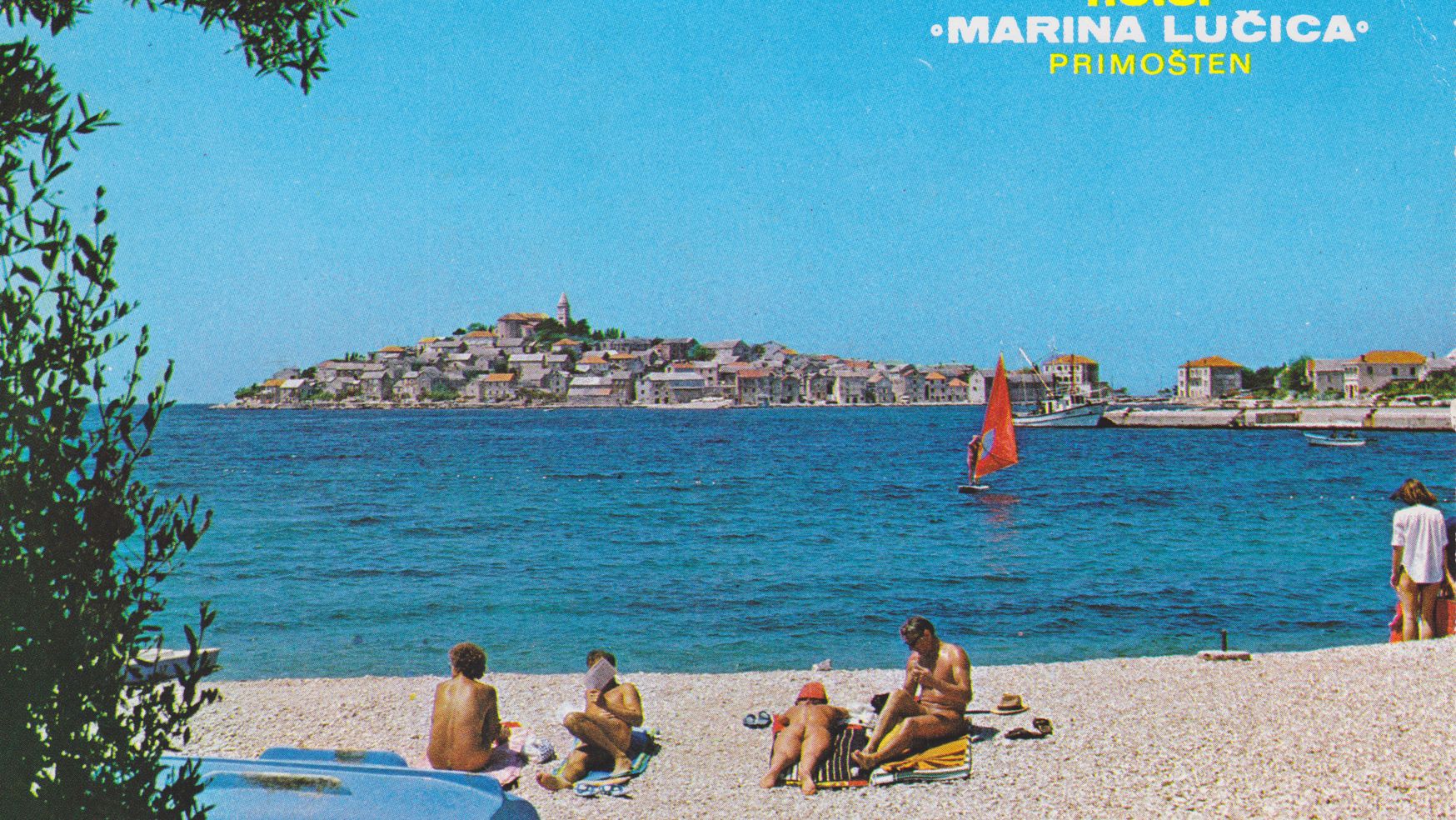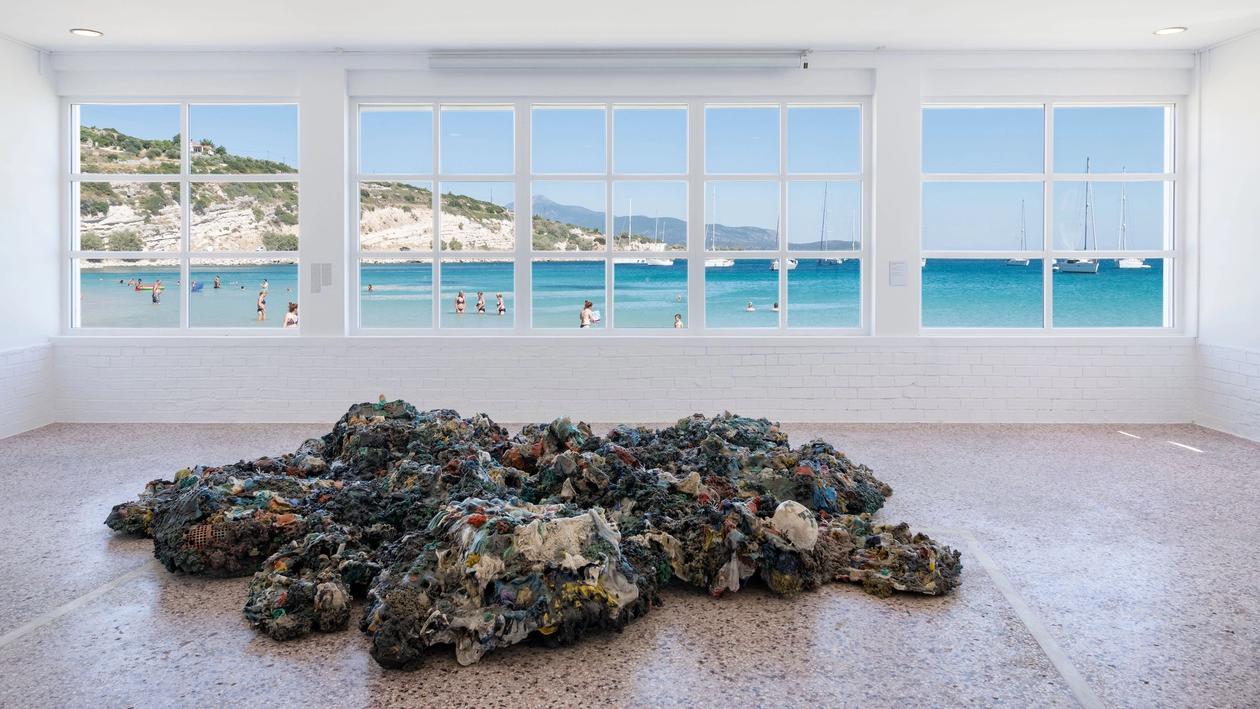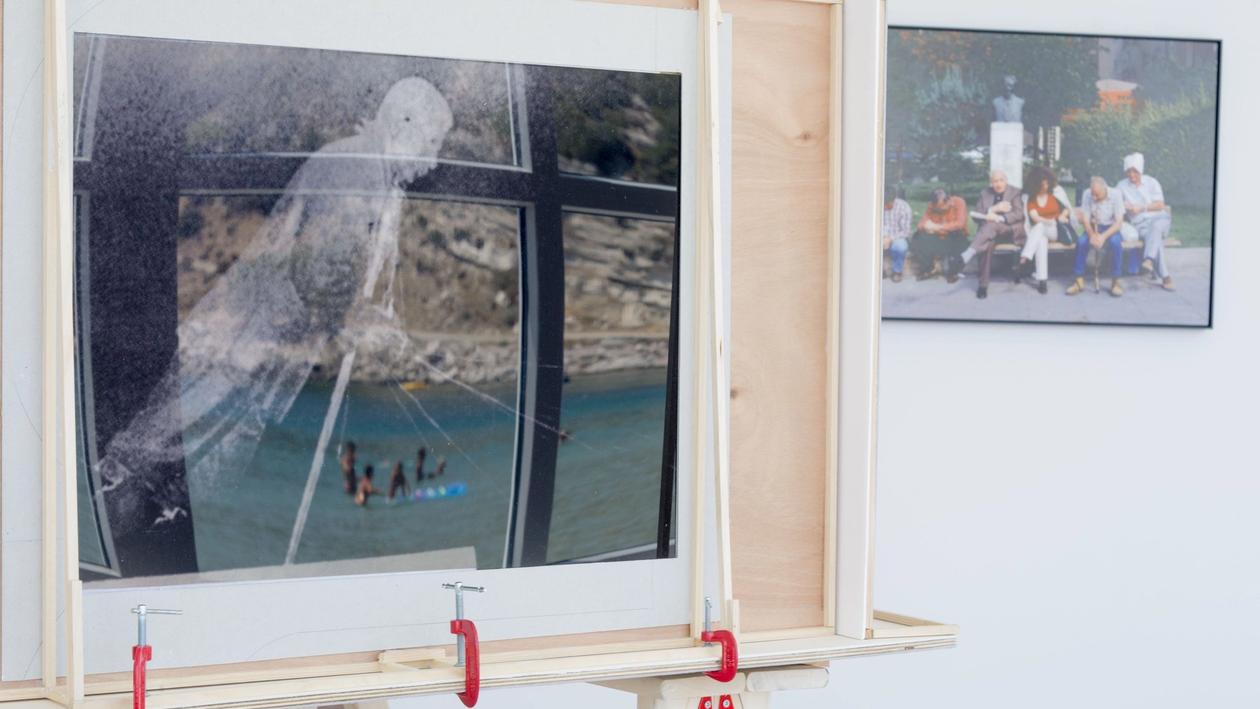
Hotel Marina Lučica

Postcard of Marina Lučica's beach with Primošten in the background

Artist
Searching For A Lost Civilisation
Boris Dežulović
Split, the city where I was born, is most attractive when seen from the sea, from the deck of a ship arriving in the harbour. Your gaze is drawn to the centre and settles, for a while, on the palm trees, before wandering behind them to explore the arcades of the palace, an edifice raised by the Roman emperor Diocletian 1,700 years ago. There your eyes become drawn to the bell tower of the Cathedral of Saint Domnius, which rises up in the heart of the imperial palace, which expands to the city spreading out around its mighty walls. At the edges of that scene, like a counterweight to the axis of the Gothic-Renaissance bell tower, there stand two large monuments of a long interregnum: the modernist cube of Hotel Marjan to the west, and to the east the tall tower of the commercial giant Koteks.
Both of these large structures arose in socialist Yugoslavia fifty or so years ago—Hotel Marjan in 1963, and the highrise Koteks building in 1964, exactly around the time I was born. Urban legend has it that they were built by directive of the League of Communists of Yugoslavia and the atheist authorities of the time in order to shift people’s gaze from the Catholic cathedral’s bell tower to the triumphal verticals of communist progress. Myths always originate from ignorance and a lack of understanding: a conservative society transforming into capitalism, like Croatia today, can only explain the openness and modernity of those times as having been a tool of godless Yugoslav communism attempting to stifle tradition and trample underfoot the glorious national history of the Croats.

Aleksandra Domanović, Portrait (kilim), 2012 (installation view)
The cube of Hotel Marjan and the vertical structure of the Koteks tower have something else in common, too: both are the work of Lovro Perković, one of Split’s most significant twentieth-century architects. Born in 1910, Perković finished his studies in Prague, and from there he brought back with him an avant-garde conception of architecture that he merged with the Mediterranean building tradition. His most acclaimed work, however, is not in Split but on the Šibenik Riviera, sixty kilometres further west along the touristic route completed in the same days as Hotel Marjan and the Koteks building—close to a picturesque old town on a small island. Long ago this was connected to the coast by a wooden bridge, today a causeway, and thus came to be called Primošten (literally: “bridged”).
Aleksandra Domanović, Untitled, 2012 (installation view)
Aleksandra Domanović, Untitled, 2012 (installation view)
When built in 1971, Perković’s Hotel Marina Lučica was quite an architectural sensation in the way it symbolically bridged the modern and the traditional, with deep respect for the landscape of Croatia’s coastal region Dalmatia, and set organically into a rocky cascade and a pine forest by the sea. It was a monument to a time and a society that paid attention to such things, which is almost unthinkable to today’s brutal, profit-making attitude toward the environment and public space. Marina Lučica was also a touristic sensation: here in forested seclusion, with seven hundred beds, sporting and recreational opportunities, and a marvellous beach with awonderful view of Primošten, this elite A-category hotel (the socialist equivalent of a capitalist five-star establishment) was also the most luxurious on the Yugoslav Adriatic coast at that time. Finally, the hotel was a social sensation—it was the first nudist hotel in Yugoslavia and thus the first resort wide open to the Western culture of nakedness.
- Thursday, August 6
Panel Discussion
- Carolyn Christov-BakargievCurator
- Andrea LissoniCurator
- Susanne PfefferArt Historian
- Paul Pieroni Curator
- Andreas AngelidakisArtist
Curatorial Fellowship
The art curatorial residency programme is a Schwarz Foundation initiative aiming to bring together young professionals from different fields of science and art. Participants acquire professional experience by actively working together with internationally acclaimed art curators. In the inspiring ambiance of a historic and cultural area of high geographic importance, residents work at a freshhold between West and East. Residents meet, interact and develop ideas and references to an extensive community. The residents actively participate in the curating and production of the Art Space Pythagorion exhibition under the curator’s guidance. The production of complementary side-events, such as opening activities, lectures, workshops, educational programmes for children and screenings also fall in their line of work.
- Resident Curators
- Gregoire Blunt and Emmy SkensvedArtists
- Klea CharitouArt Historian & Curator
- Angeliki KounavaArt Historian & Curator
- Maria NicolacopoulouIndependent Curator
- Matthew Alexander PostIndependent curator, reader, and writer
- Mateusz SapijaIndependent Curator & Researcher
- Katarzyna SobuckaCurator & Cultural Producer
- Kelly Tsipni-KolazaIndependent Curator
Press
- AQNB, Aleksandra Domanović, Hotel Marina Lučica (EN)
- Kathimerini, Margarita Pournara, From Novi Sad to Samos, via Munich (EN)
- ArtReview, Jonathan Lutes, Aleksandra Domanović, Hotel Marina Lučica (EN)
- ArtsTerritory, Curatorial Fellowship / Art Space Pythagorion (EN)
- Spike Art Magazine, Timo Feldhaus, Es War Einmal Auf Der Insel Samos (DE)
- Deutschlandfunk Kultur, Christiane Kort, Kollektive Erfahrungen auf Video (DE)
- Popaganda, Yannis Karlopoulos, Greetings from Pythagorion (GR)
- Kathimerini, Margarita Pournara, Το Pythagorion Art Space, στη Σάμο, μεταμορφώνεται στο άλλοτε δαλματικό θέρετρο Hotel Lucica (GR)
- ελculture, Argyro Bozoni, Το Πυθαγόρειο της Σάμου έχει ένα λόγο να υπερηφανεύεται (GR)
- Artic, Yannis Arvanitis, Δυο ξενοδοχεία ξαναζούν στο Art Space Pythagorion (GR)
- Kathimerini, Margarita Pournara, Από το Νόβι Σαντ στη Σάμο μέσω Μονάχου (GR)
- EfSyn, Pari Spinou, Grand Yugoslavia Hotel (GR)
- To Vima, Ελληνογερμανικός σύνδεσμος με συνέχεια (GR)
- Ta Nea, Efi Falida, Οταν η διαμονή στην Ελλάδα γίνεται τέχνη (GR)
Exhibition Brochure
Credits
- The exhibition is organized by the Schwarz Foundation; Founders:Chiona Xanthopoulou-Schwarz, Dr. Kurt Schwarz; Artistic Director and Exhibition; Curator: Dr. Andrea Lukas; Exhibition Architect:Penny Petrakou; Schwarz Foundation: Helena Kageneck; Curatorial Advisor: Marina Fokidis; Venue Curator and Fellowship Coordinator: Yannis Arvanitis; Press and Communication Consultants (Greece) Chara Zouma, Semi Psilogianni; Press and Communication Consultant (Germany/International) Anna Wichmann; Production Assistant Mia Goyette; Assistants: Vassilis Pristouris, Sergios Zalmas, Evangelia Vakiarou, Dennis Bugdoll; Greek Translation: Dimitris Saltabassis; English Translation: Will Firth; Booklet Graphic Design: John McCusker; Photo Credits:John McCusker
- All works: Courtesy the artist Aleksandra Domanović, Tanya Leighton Gallery, Berlin
- The artist would like to thank all the residents of Pythagorion for their support and for lending us their plants


